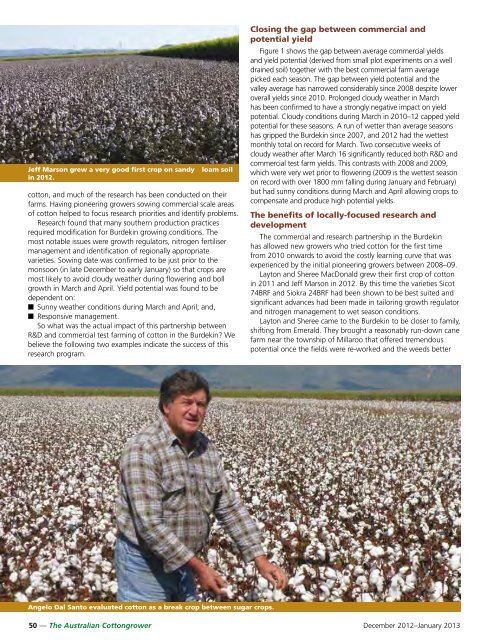cotton - Greenmount Press
cotton - Greenmount Press
cotton - Greenmount Press
You also want an ePaper? Increase the reach of your titles
YUMPU automatically turns print PDFs into web optimized ePapers that Google loves.
Jeff Marson grew a very good first crop on sandy – loam soil<br />
in 2012.<br />
<strong>cotton</strong>, and much of the research has been conducted on their<br />
farms. Having pioneering growers sowing commercial scale areas<br />
of <strong>cotton</strong> helped to focus research priorities and identify problems.<br />
Research found that many southern production practices<br />
required modification for Burdekin growing conditions. The<br />
most notable issues were growth regulators, nitrogen fertiliser<br />
management and identification of regionally appropriate<br />
varieties. Sowing date was confirmed to be just prior to the<br />
monsoon (in late December to early January) so that crops are<br />
most likely to avoid cloudy weather during flowering and boll<br />
growth in March and April. Yield potential was found to be<br />
dependent on:<br />
■ Sunny weather conditions during March and April; and,<br />
■ Responsive management.<br />
So what was the actual impact of this partnership between<br />
R&D and commercial test farming of <strong>cotton</strong> in the Burdekin We<br />
believe the following two examples indicate the success of this<br />
research program.<br />
Closing the gap between commercial and<br />
potential yield<br />
Figure 1 shows the gap between average commercial yields<br />
and yield potential (derived from small plot experiments on a well<br />
drained soil) together with the best commercial farm average<br />
picked each season. The gap between yield potential and the<br />
valley average has narrowed considerably since 2008 despite lower<br />
overall yields since 2010. Prolonged cloudy weather in March<br />
has been confirmed to have a strongly negative impact on yield<br />
potential. Cloudy conditions during March in 2010–12 capped yield<br />
potential for these seasons. A run of wetter than average seasons<br />
has gripped the Burdekin since 2007, and 2012 had the wettest<br />
monthly total on record for March. Two consecutive weeks of<br />
cloudy weather after March 16 significantly reduced both R&D and<br />
commercial test farm yields. This contrasts with 2008 and 2009,<br />
which were very wet prior to flowering (2009 is the wettest season<br />
on record with over 1800 mm falling during January and February)<br />
but had sunny conditions during March and April allowing crops to<br />
compensate and produce high potential yields.<br />
The benefits of locally-focused research and<br />
development<br />
The commercial and research partnership in the Burdekin<br />
has allowed new growers who tried <strong>cotton</strong> for the first time<br />
from 2010 onwards to avoid the costly learning curve that was<br />
experienced by the initial pioneering growers between 2008–09.<br />
Layton and Sheree MacDonald grew their first crop of <strong>cotton</strong><br />
in 2011 and Jeff Marson in 2012. By this time the varieties Sicot<br />
74BRF and Siokra 24BRF had been shown to be best suited and<br />
significant advances had been made in tailoring growth regulator<br />
and nitrogen management to wet season conditions.<br />
Layton and Sheree came to the Burdekin to be closer to family,<br />
shifting from Emerald. They brought a reasonably run-down cane<br />
farm near the township of Millaroo that offered tremendous<br />
potential once the fields were re-worked and the weeds better<br />
Angelo Dal Santo evaluated <strong>cotton</strong> as a break crop between sugar crops.<br />
50 — The Australian Cottongrower December 2012–January 2013

















